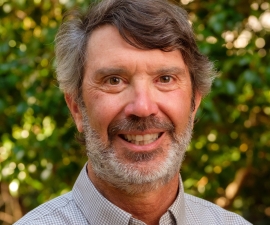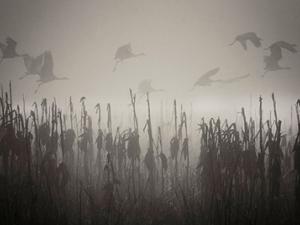

Research Bio
Dennis Baldocchi is a Distinguished Professor of Biometeorology Emeritus in the Department of Environmental Science, Policy, and Management and Professor in the Graduate School. His research program focuses on studying: ‘the physical, biological and chemical processes that govern trace gas and energy exchange between the terrestrial biosphere and the atmosphere’. In layman terms, his broad objective is to understand how the terrestrial biosphere ‘breathes’; plants and microbes exchange trace gases, in and out of the atmosphere, in their quest to acquire the energy needed to support their metabolism.
Experimental and Theoretical Approaches
His research approach involves the coordinated use of long-term, quasi-continuous trace gas flux measurements and theoretical models to study biosphere-atmosphere interactions. The eddy covariance technique is the primary experimental method he uses, and helped pioneer, to measure CO2, water vapor and methane exchange across natural ecosystems. This micrometeorological method uses sonic anemometry and infrared spectroscopy to measure the covariance between vertical wind velocity and fluctuations in the concentration of greenhouse gases (water vapor, carbon dioxide and methane) and temperature. Fluxes deduced by this method are direct, continuous, and in situ, making them representative of the integrated vegetation-soil system at the stand scale and without disturbing the underlying vegetation. To interpret these flux measurement, his field studies also involve measuring a comprehensive suite of biophysical variables. These measurements includes the physiological status of the vegetation and leaves (photosynthetic capacity, stomatal and mesophyll conductances, pre-dawn water potential, sapflow), biological activity of the soil (soil respiration, soil CO2) the physical structure of the canopy (leaf area index, canopy height, leaf area index, its vertical distribution and seasonal phenology and root population) and the physical and chemical properties of the soil and water (water table depth, texture, evaporation, heat transfer, hydraulic conductivity, carbon and nitrogen content, root distribution, oxygen concentration). To upscale their flux information in space, they rely on hyperspectral remote sensing and LIDAR, collected either at on towers at their field sites, by aircraft or from satellites circling the planet and flux footprint modeling to determine where the gases are going to or coming from.
Since coming to Berkeley, he has established nine biometeorological flux field study sites that are measuring carbon dioxide, water and energy fluxes continuously and for multiple years; five of these sites are also measuring methane fluxes. One set of sites started circa 2000/2001 and are associated with semi-arid ecosystems; one site is over an annual grassland and the other is over an oak grass savanna, near Ione, CA. The goal of this work is to examine how contrasting plant functional types (trees vs grasses) have adapted to their semi-arid climate and how their carbon metabolism and water balance responds to climate and weather forcings and seasonal drought. Because of the Mediterranean climate, this set of sites is a natural laboratory for understanding how ecosystems respond to seasonal and interannual variations in rainfall and temperature.
The second set of sites is associated with drained peatlands and tidal and non-tidal restored wetlands in the Sacramento-San Joaquin Delta. In this region they are or have collected long-term greenhouse gas flux measurements over a degraded peatland pasture, 3 newly restored wetlands, a 19 year-old restored wetland and a suite of agricultural crops (alfalfa, corn, rice, pasture). There, their goal is to study the unanticipated effects of wetland restoration, land use, land use change and weather on greenhouse gas fluxes (water vapor, carbon dioxide and methane). This project gives them an opportunity to study the scientific, management and policy aspects of this system. It is noteworthy that the Delta is the conduit of water transfer for over 20 million Californians. The Delta is vulnerable because over 10 m of peat have subsided since it was drained 100 plus years ago for agricultural. They have developed strategies to stem or reverse further soil subsidence to prevent this levee system from collapsing because much of the land is below sea level, and understand the ecosystem costs and benefits of doing so. Replacing agriculture with flooded rice or wetlands are two options. In recent years we have establihsed a set of restored wetlands that are influenced by tides and a salinity gradient across the Bay estuary.
We extend the scope the scope of our flux measurement work to the national and global scales, by our roles in national Ameriflux and the global FLUXNET project (http://fluxnet.fluxdata.org/) projects. Through the FLUXNET and AmeriFlux projects, a functional database on flux and meteorological information from over 400 sites and 2500 site years of data is shared world wide. This database is proving to be a critical resource for producing the next generation of earth science synthesis studies on: 1) the differential control of carbon and water fluxes across climate and ecological gradients; 2) the upscaling of network fluxes to the region and globe with remote sensing; and 3) the validation of vegetation-land-atmosphere transfer models that compute the lower boundary condition of weather, climate and biogeochemical cycling models.
Baldocchi is a Fellow of the American Geophysical Union and American Meteorological Society. He is a recipient of the AGU Ambassador Award, the AMS Suomi Medal, the Prince Sultan Abdulaziz International Prize for Surface Water, and a Doctor Honoris Causa from Wageningen University. In 2025, he spent two months as a Gauss Professor in the Goettingen Academy of Sciences and Humanties in Lower Saxony. He is also a highly cited scientist, as designated by Clarivates and Stanford Elsevier (7th among the top 2% of Earth and Environmental Scientists).
Research Expertise and Interest
biometeorology, climate change and ecosystems, biosphere-atmosphere interactions, agricultural meteorology, ecosystem ecology, carbon cycle, evaporation, ecohydrology
In the News
Falling levels of air pollution drove decline in California’s tule fog
Central Valley sees big drop in wintertime fog needed by fruit and nut crops
California’s winter tule fog – hated by drivers, but needed by fruit and nut trees – has declined dramatically over the past three decades, raising a red flag for the state’s multibillion dollar agricultural industry, according to researchers at UC Berkeley.
Can California fix the Delta before disaster strikes?
Finding ways to better manage the overlapping infrastructure systems in the Sacramento-San Joaquin River Delta is the goal of a four-year, $2 million project headed by UC Berkeley researchers and funded by the National Science Foundation.



